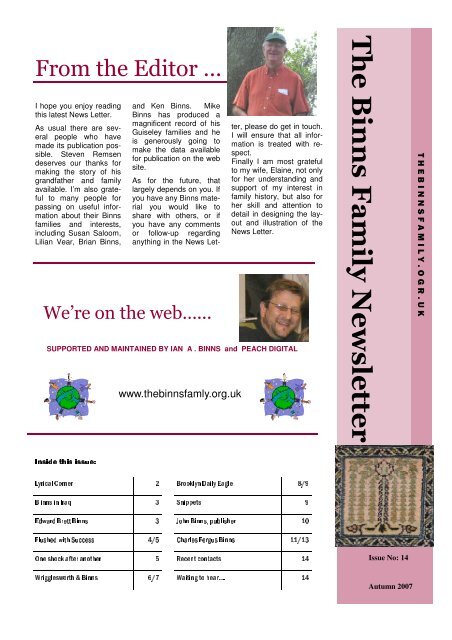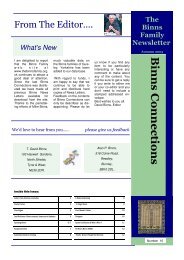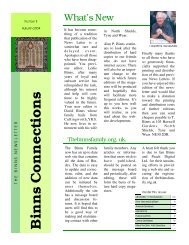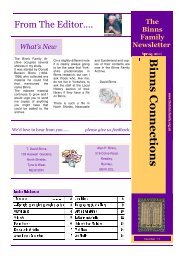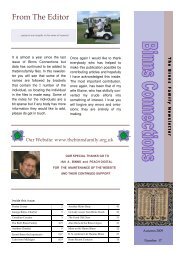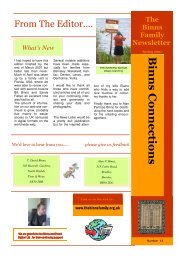14 newsletter - The Binns Family
14 newsletter - The Binns Family
14 newsletter - The Binns Family
You also want an ePaper? Increase the reach of your titles
YUMPU automatically turns print PDFs into web optimized ePapers that Google loves.
3DJH/\ULFDO&RUQHU7+(%,116)$0,/
%LQQVLQ,UDTOn 2 October 2007, Major GeneralGraham <strong>Binns</strong>, who is theGeneral Officer Commanding allBritish troops in Iraq, greeted andshook hands with Prime MinisterGordon Brown on his arrival atBasra Air Station.It reminded me that other <strong>Binns</strong>eshave had military experience inthat part of the world.Private Albert Edward <strong>Binns</strong>, sonof Henry and Esther <strong>Binns</strong>, ofGlascote and husband of SarahElizabeth Brittain, died in Iraq on25 th February 1917, and is commemoratedon the Basra Memorial.Also in Iraq but at Amara Cemeterylies Private H <strong>Binns</strong> of theManchester Regiment, 1 st Battalion,who died on 9 th January 1917.I have no information regarding hisage or identity.Strangely, by coincidence, a PrivateHarry <strong>Binns</strong> of the East LancashireRegiment, 6 th Battalion,who died on the 8 th May 1917, iscommemorated on the Basra memorial.Again I have no further informationon this soldier and Iwonder if it is possible that, althoughthey have different servicenumbers, Private H and PrivateHarry are one individual.2 nd Lieutenant, John Eric <strong>Binns</strong>,son of John D <strong>Binns</strong>, of Croydon,served in the Wiltshire Regiment,3 rd Battalion, attached to 5 th Battalion,died age 22 years on 9 April1916. He also is commemoratedon the Basra Memorial.(GZDUG%UHWW%LQQVTrawling through a variety ofonline archive sources, I was intriguedby the numerous references,dating from about 1900 to1940, to a <strong>Binns</strong> who was anagent for the honourable CharlesWilloughby, Earl of Ancasterwhose seat was Grimsthorp Castle,Lincolnshire. <strong>The</strong> <strong>Binns</strong> inquestion appeared variously asEdward Brett <strong>Binns</strong>, Edward R.<strong>Binns</strong>, and E.R.B. <strong>Binns</strong>, but Icould find no mention of him in our<strong>Binns</strong> databases.However when the 1901 Censusfor England became available asearch for Edward <strong>Binns</strong> in Lincolnshirefound 33-year old EdwardR. B. <strong>Binns</strong>, land steward, atGrimsthorpe, with his wife AnnieLouisa, and children Muriel andClarence. Surprisingly he wasborn in West Bromwich, Staffordshire,not a well known <strong>Binns</strong> familystronghold. An online search ofbirths failed to find a reference thatcould be attributed to Edward<strong>Binns</strong>; but there is the birth of anEdward Brett registered in WestBromwich in the September Quarterof 1867. Clearly this could bethe man and a search of the 1881Census found him in Monmouthshire,Wales as a 13-year old,scholar living with his grandparents,Edward and Hannah Brett.He is named as Edward RichardBrett and other members of the Bretthousehold are three unmarrieddaughters, Rachel, Hannah M, andMargaret, ages age 34, 32, and 27respectively, and a son FrederickWilliam Brett, age 23, a colliery cashier.John Morris, age 39, an independentminister of a chapel inEbww Vale, was an unmarried visitor.It was not difficult to find the Brettfamily in the 1871 Census but it wasgratifying to see 3-year old Edwardrecorded there as Edward R. <strong>Binns</strong>,however he is the only <strong>Binns</strong> present.<strong>The</strong> three Brett daughters areall at home and unmarried and it isimpossible to decide which if any ofthem may be the mother of Edward.Moving forward to 1891, EdwardRichard Brett <strong>Binns</strong> is revealed as anunmarried lodger at Main Street,Empingham, Rutland, age 23, andhe is now a surveyor and draughtsman.<strong>The</strong> unmarried head of thehousehold was Margaret Summerhall,age 44. It seems almost certainthat Edward was already employedon the Grimsthorpe Castle Estate,and clearly his grandfather EdwardBrett, who was born in Dublin, andhad been an agent and later a superintendentin a tin plate works, hadsecured him a good education.In June Quarter 1892, the marriageof Edward Richard B. <strong>Binns</strong> to AnnieLouisa Benn was registered in Holbeck,Yorkshire, and childrenMuriel Emily, Clarence Edward B[Brett?], Leslie Reginald, MarjorieAnnie, and George Henry wereborn at regular intervals between1894 and 1906. However the familymust have suffered greatlywhen Annie Louisa died, agedonly 40, in Grimsthorpe on 19 thFebruary 1910. Probate for £409was granted to her husband on 2May 1910, in Lincoln.Clarence Edward Brett <strong>Binns</strong>, appearsto have joined the war effortat an early stage since already inNovember 1915 the London Gazettereported that he was to be atemporary 2 nd Lieutenant in thePrince of Wales Volunteers, SouthLancashire Regiment. Towardsthe end of the war, in 1918, hewas transferred to the Royal FlyingCorps. His name is mentioned in acompilation of data titled“Prominent People of Bourne” andthat suggests that he died in 1975.Of the other children it would seemprobable that Emily married in1920 and George in 1925, but I’mhoping that one of these days thisstory will strike a chord with a descendantof Edward Richard Brett<strong>Binns</strong> and they will be able to fill insome of the details.7+(%,116)$0,/
:ULJJOHVZRUWK %LQQV<strong>The</strong> newspapers of New Zealand in the late 1800’sand early 1900’s would have looked very differentwithout the contributions of the photographers Wrigglesworthand <strong>Binns</strong>. For instance the WellingtonEvening Post of 11th May 1888, reported that the“most important match which has ever been playedin this city will take place tomorrow when the firstEnglish team that has visited the Southern Hemispherewill meet the best fifteen in Wellington.” “<strong>The</strong>teams will be photographed by Messrs. Wrigglesworthand <strong>Binns</strong> at 2.45, and the public whomay be on the ground at that time will be offered anexcellent opportunity of making themselves acquaintedwith the personal appearances of each ofthe visitors.”D J Wrigglesworth came from Melbourne, Australia,and started the business in Wellington in 1863.Shortly afterwards he was joined in partnership byFrederick Charles <strong>Binns</strong>, who came from London,and they established branches in Christchurch andDunedin. Both Wrigglesworth and <strong>Binns</strong> had eventfulpersonal lives. Wrigglesworth was a capableamateur actor and his daughter made a career onthe stage as ‘Kate Gair’. He was married threetimes, his first wife and family having drowned whenthe barque ‘Cyrus’ was wrecked at Happy Valleyshortly after leaving port in Wellington. His secondwife was the mother of the above daughter and histhird wife gave him a son. <strong>The</strong> family went back toMelbourne in August 1906 and Wrigglesworth diedthere, aged about seventy, in October the sameyear.As mentioned above, <strong>Binns</strong> was a Londoner and in1851 at 43 Trinity Square, Lambeth, Surrey, we findmarried head William <strong>Binns</strong>, age 36, born Lancashirewith his wife Mary Ann age 39, born Halifax;Frederick C., son age 7, born Lambeth and Emily,daughter age 5. Also present were Thomas Ellis,unmarried lodger age 19, an engineering student,born Hayes and an unmarried visitor Mary Ogden,age 21, born Halifax. <strong>The</strong>y had a 20-year old femaleservant.By the time of the 1861 Census the family appear tohave gone up in the world and are now at 15 EdithGrove, Chelsea, Middlesex, where the married headis William <strong>Binns</strong>, age 46, engineer, born Oldham,Lancashire with his wife Mary A, age 49, born Halifax;Frederick C., unmarried son, age 17, no occupationrecorded, born Southwark; and William H,son age 12, scholar, born Southwark. <strong>The</strong>y stillhave an unmarried female servant. Daughter Emilyappears to be a 15 year old pupil at Greenhill HouseSchool, at Church Street, in Stourbridge, Worcestershire.<strong>The</strong> school had about 21 pupils age 9 to 17and was run by Frances A, Rebecca H, andSusanna Sugden the unmarried daughters of FrancesSugden, age 69, the widow of a Wesleyan Minister.3DJH7+(%,116)$0,/
:ULJJOHVZRUWK %LQQV²FRQWGNot surprisingly, the family are notrecorded in England in the 1871Census in England and on 21 stJanuary 1871 it was reported thatFrederick’s his wife had given birthto a son at Haining Street, Wellington,New Zealand.Whether the <strong>Binns</strong>es were particularlyaccident prone we don’tknow, but we read in the WellingtonPost of 22 nd Jun 1879 :-An extraordinary explosion, whichoccurred this morning in the houseof Mr. F. C. <strong>Binns</strong>, College street,should be a lesson to our coalmerchants to take care that thecoal they sell is as free as possiblefrom explosive materials. <strong>The</strong> firehad been lighted as usual, the coalbeing from West Wanganui Mine.Suddenly, a tremendous explosiontook place, blowing the whole ofthe fire right out into the room, andbringing down all the plaster fromthe chimney. Fortunately, the twochildren, who were right in front ofthe fireplace a moment before,had just moved to one side, orthey must have been either killedor seriously injured, but as it was,they were out of the ‘line of fire.’Mrs. <strong>Binns</strong> received a severe blowin her face, and sustained somebruises, one of her eyes too, beinginjured. Mr. <strong>Binns</strong> himself wasslightly struck. When the smokeand dust cleared away the coppercase of a dynamite cartridge,which had evidently been intendedfor use in the mine and accidentallyleft in the coal, was picked upon the floor.Had the explosion taken place in aLeamington range, or under aboiler, or anywhere but in an openfireplace, the consequences mighthave been most disastrous.Again on 2 nd December 1898, it isreported that Mrs. <strong>Binns</strong> was gettinginto her trap when “the horseshied at some cement casks andbacked the trap causing her to fall,and fracture her ankle.”<strong>The</strong> bad luck continued when on18 January 1901 it was reported“Two three-storey warehouses inWillis Street- those of Wrigglesworthand <strong>Binns</strong>, photographersand the Singer Sewing MachineCompany-were totally destroyedby a fire which broke outat five this morning. It is presumedto have started on the middle floorof Wrigglesworth and <strong>Binns</strong>’, at theback. Luckily it was dead calm andthe Fire Brigade was able to preventthe spread of the flames tothe adjoining buildings.Bad luck finally did for FrederickCharles <strong>Binns</strong> in August 1915when his accidental death was reported:-(By TELEGRAPH - PRESS AS-SOCIATION)CHRISTCHURCH, 13 th August.While proceeding to business thismorning Mr. F. C. <strong>Binns</strong> of the firmof Wrigglesworth and <strong>Binns</strong>, wasthe victim of a collision which occurredbetween a motor car and amotor-cycle with a side-chair attached,in Victoria street. Mr.<strong>Binns</strong>, who is 71 years of age, wasby some means knocked over byone of the vehicles and sustainedsevere injuries which necessitatedhis immediate removal to theChristchurch Hospital, where heexpired as the result of the injurieshe had sustained.<strong>The</strong> late Mr. <strong>Binns</strong> was born in1844 in London, where he wasbrought up as a civil engineer, butdevoted most of his time to amateurphotography, and shortly afterhis arrival in Wellington in 1864 hebecame associated with Mr., Wrigglesworth,and established thepartnership which had continuedever since.Mr. <strong>Binns</strong> was one of the mostprominent Freemasons in New Zealand;he was initiated in 1873 in thePacific Lodge, Wellington, and wasMaster of the Lodge in 1878 and1880. Subsequently he became theZ. V. in the Royal Arch Chapter, wastwice Grand Senior Warden of theGrand Lodge of Wellington (EnglishConstitution) and for a time, was alsotreasurer.With the Pacific Lodge he came overto the New Zealand Constitution, andlater on, on coming to Christchurch,he affiliated with St. AugustineLodge. He was installed as GrandSuperintendent of Canterbury in1902 and on the inauguration of theProvincial Grand Lodge, as GrandMaster, an office which he held tillhis death. He was a foundationmember of the Civic Lodge. Mr.<strong>Binns</strong> was also Grand Master(honoris causa) of Grand Lodge ofNew Zealand in 1911, and he wasalso Pro-Grand Master in 1906-08.<strong>The</strong> funeral will take place on Monday,at 2.30 p.m.<strong>The</strong> driver of the motor car, Mr.Pearce Power, who knocked Mr.<strong>Binns</strong> down, was arrested and triedfor manslaughter.In his time Frederick Charles <strong>Binns</strong>had, among other achievements,been asked by the Wellington RiflesVolunteers to be second lieutenant ofthe D Battery of Artillery; had been acommittee member of WellingtonAmateur Operatic Society; and avestryman of St Peter’s ParishChurch, Wellington.7+(%,116)$0,/
%URRNO\Q'DLO\(DJOH7 Oct 1874<strong>The</strong> ancient rule of Law “that noman shall be twice place in jeopardyof life or liberty” seems tohave lost its attractions for thecriminal population. Here is Jonathan<strong>Binns</strong> of Kokomo, Indiana,for instance whose chief pleasurein life since he has been preventedfrom knocking other people on thehead, is in being tried and foundguilty of the murder of his wife. Hehas been before a jury of his countrymentwice already and both occasionsthat intelligent body foundhim guilty of the crime mentioned,and Court sentenced him to prisonfor life. This very mild reward of hisatrocity might have satisfied evenan innocent man; but Jonathan<strong>Binns</strong> says no, he wants a thirdtrial even at the risk of a sentencewhich would involve the servicesof a hang man. Meantime theKokomo journals are dissatisfiedwith the pecuniary aspects of thecase, as each trial costs theCounty $5,000, and if Jonathancan have a third trial, why not afourth-but in short are taxes raisedfor the accommodation of Jonathan<strong>Binns</strong>?9 Mar 1878A RAILROAD BOUGHT FORNOTHING AND SOLD FOR $300,000A $500,000 MORTGAGE GIVENBACK-A MOST REMARKABLETRANSACTION, WHICH IS DIS-CLOSED BY THE RECORDS OFTHE COURTS AND THE REGIS-TER’S OFFICEJames <strong>Binns</strong>, of Walworth Street,bought the old bobtail Flatbushand Coney Island Railroad in anaction to sequestrate the property.<strong>Binns</strong> then sold it to John HWashburne for $3,200, and receivedin payment two drafts,which went to protest. <strong>Binns</strong> neverreceived one cent of the money.By request he gave a receipt asthough the purchase money were$10,000.John H Washburne, with thesedrafts that went to protest, boughthe railroad for others in trust, who3DJHformed themselves into the Brooklyn,Rockaway and Coney IslandRailway Company. This new companysay that they propose to runsteam from Flatbush, through Flatlands,along the Kings Highway, toGravesend Avenue, and along thatavenue to Coney Island.<strong>The</strong>re is on record in the Register’soffice of Kings County a conveyanceof the old railroad, sold by<strong>Binns</strong> to Washburne for paperwhich was dishonoured. In thisconveyance Washburne, as trustee,hands over to Ambrose WThompson, E Allen Perkins andAddison Crosby, the whole of theproperty which Washburne boughtfrom <strong>Binns</strong> with drafts that weredishonoured. <strong>The</strong> deed shows thatthe consideration for whichWashburne conveys the property,for which <strong>Binns</strong> received not onecent from him, is $300,000.5 Dec 1893David W <strong>Binns</strong> and Martha M<strong>Binns</strong> and Emma E Taylor,executors of will of James andElizabeth <strong>Binns</strong>, of Brooklyn arrangedfor sale of land and propertyin Brooklyn6 May 1894Sadie <strong>Binns</strong> and Warren <strong>Binns</strong>guests at May dance and banquetin honour of Bayonne Boat Club6 Aug 1896Mortgage granted by J <strong>Binns</strong> to WA <strong>Binns</strong>2 Sep 1896Mr. and Mrs. D. W. <strong>Binns</strong> and MissM M <strong>Binns</strong> arrived at ClarendonHotel7 Apr 1898Supreme Court dismisses actionbrought by Receiver against SethL Kenney, Elbert Snedeker andDavid W. <strong>Binns</strong>, three of the directorsof the defunct CommercialBank which suspended businessin August 1894. Mr <strong>Binns</strong> was presentin Court.9 Apr 1898“BINNS DEATH A MYSTERY; AP-PARENTLY ASPHYXIATED, YETHIS STORE HAD NO GAS CON-NECTIONS; FOUND DEAD ONTHE FLOOR; NEIGHBORS MADEILL BY AN OVERPOWERINGODOR OF GAS, YET THERE ISNOTHING TO INDICTE WHERE ITCAME FROM-BODY DISCOV-ERED BY A PEDDLER-POLICETRYING TO SOLVE THE PUZZLE….It concerns the death of Leonidas<strong>Binns</strong>, 65-years old, of 12Snediker Avenue, who was founddead last night between 5 and 6o’clock in his little store at 2,532 AtlanticAvenue.<strong>Binns</strong> was at one time a wealthyimporter of ostrich feathers andowned a farm in South Africa. Hewas formerly in business at 577Broadway, Manhattan. He conducteda millinery trade, but made aspeciality of ostrich feathers.Twenrt years ago he met with reversesand failed in business. Hewas a thoroughly honest man andsettled all his obligations. He afterwardcame to Brooklyn and startedup in business on a small scale atthe Atlantic Avenue address. Hewas a bachelor and lived with hisbrother, George Napoleon <strong>Binns</strong>.William Ryan, a peddler, entered<strong>Binns</strong>’ store last evening and foundthe old man’s body lying on thefloor. Ryan thought at first that<strong>Binns</strong> was drunk, but when he triedto rouse him discovered that hewas apparently dead. <strong>The</strong>re was astrong smell of gas in the shop.Ryan ran next door and told AndrewHack, a butcher, and then notifiedRoundsman Webb and PolicemanTwillman of the Seventeenthprecinct. <strong>The</strong> policeman sentin a call for an ambulance from StMary’s Hospital and Surgeon Fitzgeraldresponded.<strong>Binns</strong>’ body was still warm, and itwas carried out into the street,where the surgeon made severalunsuccessful attempts to revive theman. <strong>The</strong> body was then carriedback into the store and Coroner Delapwas notified.<strong>The</strong> strong odor of gas in the room7+(%,116)$0,/
%URRNO\Q'DLO\(DJOH&RQWGwhere the body was found naturallyled the police to believe that <strong>Binns</strong>had committed suicide. To makesure that he had done so an investigationwas instituted, but though athorough search of the building wasmade, no gas meter was found. <strong>The</strong>house is connected with the gasmain, but there are no fixtures in theplace, and <strong>Binns</strong>’ brother says thatthe dead man never used gas in hisstore.At the time when the body wasfound, it was learned this morning,the families who occupy the houseson either side of the one in which<strong>Binns</strong> kept his store were almostoverpowered by gas in their apartments.Mrs. Esther Isaacs and MrsO’Toole who live in 2,530, said to areporter that they were obliged toleave their rooms on account of thegas.<strong>The</strong> smell was so strong in the apartmentsof Andrew Hack, in 2,534, thatMrs Hack was made sick, and whenthe body was found she was sufferingseverely. Mrs Heidekamp, wholives in 2,536, two houses away, wasalso annoyed somewhat by the gas.Although Frank Maurer, an Italianshoemaker , who lives at 2,350,said that he did not smell any gasyesterday in his rooms, the odor inhis store could be detected thismorning.Notwithstanding the statement thatthe police could not find a meter inthe house last night Butcher Hacksaid that he saw a man taking ameter away from the house thismorning. This statement was corroboratedby a policeman. At theoffice of the Union Gas Companyon Atlantic Avenue and Ashford, areporter was informed that no meterwas removed from the housethis morning because no ordershad been received by the companyto remove it. An employee ofthe company would not take a meteraway unless he was ordered todo so by the office.In <strong>Binns</strong>’ shop the gas pipes are tobe seen and all of them have theregulation plugs on them. Uponthe statements, however, that<strong>Binns</strong> never used gas in the storeand that there was a meter removedfrom the building thismorning, the police or the Coronerwill make an investigation. CoronerDelap will hold an inquestsome time today.As far as I can discover nothing moreregarding this bizarre report waspublished in the Brooklyn Daily Eagle.6 Aug 1902Fire brigade Battalion Chief, andseveral firemen overcome bysmoke at 38 Bond St., Manhattan6 Aug 1902Jamaica, Long Island, executors ofDavid <strong>Binns</strong> obtain judgementagainst Mayor of Brooklyn re 25building lots.6QLSSHWVL.J.<strong>Binns</strong> was an English caricaturist of English celebrities, including for example Sir Henry Irving, Sir ArthurWing Pinero, Sir Herbert Beerbohm Tree, Mrs. Patrick Campbell, James Keir Hardy, Lillie Langtry, W. T. Stead,Richard D’Oyle Carte, and Dan Leno.John <strong>Binns</strong> was born at Woodhouse Carr in Leeds on March 31, 1870 and died at Leeds on December 8, 1934.He played one first-class match for Yorkshire in 1898. He scored four runs and stumped three Leicestershirebatsmen [from Wikipedia].<strong>The</strong> Ship "Royal Bounty" 360 tons, consigned to Charles <strong>Binns</strong>, of Charlottetown, Prince Edward Island, sailedfrom Hull on 8 June, 1812 and was captured and burned by the "Yankee", Capt. Oliver Wilson, of Rhode Islandon 31 July, 1812.Banns were read in December 1875 at Fort St George, Madras, India, for the marriage of bachelor ThomasHosking, Private 89 th Regiment to widow Jane <strong>Binns</strong>. <strong>The</strong> marriage took place in January 18767+(%,116)$0,/
-RKQ%LQQVRI/HHGV²SULQWHUDQGSXEOLVKHUA John Heaton thought so highlyof his friend John <strong>Binns</strong> that hesubmitted the following article toWilliam Bowyer for inclusion in hisLiterary Anecdotes of the 18 thCentury that was published in18<strong>14</strong>Literary Anecdotes of the 18 thCentury: Comprising BiographicalMemoirs of William Bowyer;Volume 8, 18<strong>14</strong>“My old acquaintance, the late MrJohn <strong>Binns</strong>, of Leeds, and anotherbookseller, Mr Samuel Fox formerlyof Derby, are both worthy ofbeing inrolled in your list.“ <strong>The</strong> following copy of a letterfrom Mr Heaton, bookseller inLeeds, dated Dec 24, 1812, willconvey a pretty good account ofMr <strong>Binns</strong>, who was indeed a mostrespectable man. I frequentlycalled on him on my way throughYorkshire; and had, till lately, severalof his printed catalogues, onlyone of which I can now find; it consistsof 182 pages, said to containseveral valuable libraries, and thesale commenced in October1792:”Mr. John <strong>Binns</strong>, bookseller,Leeds, was the eldest son of Nathaniel<strong>Binns</strong>, bookseller, Halifax.He was taught the art of bookbindingand the other introductoryparts of his business under the paternalroof. About the age oftwenty he left his father, and residedin London for some time,employed in the house of MrCrowder, book seller, much to thesatisfaction of his employers.From thence he removed toLeeds, where he commencedbusiness on his own account, andwhere he prosecuted it with avidityand singular success.Mr <strong>Binns</strong> published his first cataloguein 1767; and continued topublish one, for some time, everytwo or three years; but for manyyears previous to his decease hepublished a catalogue annually. Mr<strong>Binns</strong> bought several times manygood libraries; among which were,the Rev. Mr. Colby, the Rev Mr.Seddon, Henry Squire esq., theRev. Mr. Scott, the Rev. Mr. Hodgson,the Rev. Mr. Brooke, the Rev.Mr. Whitaker, the Rev. Mr. Potter,the Rev. Mr. Tennant, the Rev. Dr.Leigh, Dr. Joseph Milner, Dr. SamuelDavenport, &etc.Mr <strong>Binns</strong> was in business about 30years. He died at Grantham, onhis journey from London, May 6,1796, aged 52 years. He was interredin St Peter’s Church, Leeds,where a handsome marble monumentis erected to his memory.Mr <strong>Binns</strong> was twice married; thechildren by his first wife all died ininfancy; by his second wife he lefttwo sons and three daughters; thesons and second daughter aresince dead; his widow and daughtersSarah and Eliza are all of hisfamily that survive him.He was immediately succeeded inthe business by his eldest sonJohn; but he, being of a delicateconstitution died in a few years.<strong>The</strong> second son, Thomas, thenentered upon the business, who,as well as his brother, engagedJohn Heaton to superintend andtake the executive parts of thebusiness, and who now succeedsthem in the same premises, whichhe commenced in consequence ofthe second son’s (Thomas) severeillness and subsequent death.J. Heaton has, since his commencement,published three catalogues;and has in his possessioncopies of all the catalogues publishedby Mr. <strong>Binns</strong>, which werehis own marked copies, with occasionalnotes by himself.Mr <strong>Binns</strong> was a very respectableamateur performer both on the violoncelloand violin, the former ofwhich was his favourite instrument.His attainments in the scienceof musick were far beyondmediocrity; about his eighteenthyear he compiled a Dictionary ofMusick, which, a few years after,was published under the name ofHoyle.He was most indefatigable in business;and his bibliographicalknowledge was excelled by few inthe County. – He was a partner inthe Leeds Commercial Bank, underthe firm of Scott, <strong>Binns</strong>,Nicholson, and Smith, from itscommencement until his death.John Heaton3DJH7+(%,116)$0,/
&KDUOHV)HUJXV%LQQVIn 1857, Richard William <strong>Binns</strong>,with his wife Elizabeth (Ferrar),was living at the Poplars, England,when on an October Sunday their5th child was born and theynamed him Charles. Four morechildren were born to Mr. and Mrs.<strong>Binns</strong>, and, though nine was notand unusually large family forthose days, it must have beensomething of an anxiety to feed,clothe, and educate them. A bighouse was essential and the familygrew up at Diglis House on thebanks of the River Severn inWorcester, where old trees andthick grass, a paddock for a pony,their mother's aviary, and the ramblinghouse, running over with children,cats, dogs and a parrot,made the much loved backgroundto their lives.Governess taught the childrenat first, then the oldest sistertook charge of the little ones, andas early as practicable, the boyswere sent to the "Worcester CathedralKings School". To a youngmodern, the length, or rathershortness of time during which formalschool was attended is almostincredible. Charles <strong>Binns</strong> enteredthe school when he was eleven.Although the Classics wereemphasized in most Englishschools, mathematics and naturalsciences were not neglected and itwas in the latter subjects thatyoung Charles earned his prizes.In 1872 his attendance at schoolceased and he was apprenticed tothe Royal Worcester PorcelainWorks of which his father wasmanaging director. In order tomaster the problems of ceramicsyoung Mr. <strong>Binns</strong> wished to studychemistry, and as the city ofWorcester offered no facilities forsuch work, he journeyed twice aweek to larger Birmingham wherehe proceeded to take prizes oncemore. Those who knew him in hislater academic life will marvel athis scant schooling. That he becamea scholar of parts in his ownfield, is accounted for by the backgroundof learning in the family,his own industry and ability, and7+(%,116)$0,/
&KDUOHV)HUJXV%LQQVFRQWGA new life began when PresidentDavis of Alfred University visitedMr. <strong>Binns</strong> in 1900, and as Mrs.<strong>Binns</strong> always said, after eating agood dinner with her special jampudding for dessert, offered himthe position of Director of thenewly created department of Ceramicsat Alfred.Early in the summer of thatyear, the family, still somewhat foreign,shy and shabby, arrived atthe Station, rode to Alfred in the"Corn Popper”, a historic conveyancesoon to be familiar and beloved,and began a life which wasto be both happy and fruitful.<strong>The</strong> New Ceramic School,now the "old building" and recentlychristened "<strong>Binns</strong> Hall", was underconstruction, and the first classes,with Professor <strong>Binns</strong> and oneteacher of drawing and design asthe staff, were held in the Gothic.Needless to say the number ofstudents at first was small. Onlyone other college was offeringcourses in Ceramics, at Ohio StateUniversity, where such a departmenthad been organized fiveyears earlier. <strong>The</strong> word itself wasscarcely known except to museumhabitués. Amusing remarks wereconstantly overheard, such as onetraveler on the Erie made to anotheras they neared Alfred Station.“This is where they have aschool of Ceramics or something.It has to do with undertaking, Iguess".<strong>The</strong> family thrived. It was aneasy matter to make friends in cordiallittle Alfred. Faculty membersand their wives were found hospitableand congenial, and, since itis always the ambition of youngpeople to be as much like fishes,as possible, in a short time the<strong>Binns</strong>es could hardly be told fromany young Americans. Professorand Mrs. <strong>Binns</strong> naturally weremembers of the Anglican Church,with generations of clergymen anddevout ancestors on both sides ofthe family. Upon finding the villageto be wholly Seventh Day Baptistwith no service on Sunday exceptduring the college session, and noEpiscopal service at any time, they3DJHfelt they must arrange for their ownform of worship. <strong>The</strong> college authorities,particularly PresidentDavis, with more than tolerance,even with generosity, assistedthen in every way.A small room in the Gothic wasgiven to be used as a chapel. Afew Episcopalians were foundamong the faculty and residents ofthe village, and thus, with the sizable<strong>Binns</strong> family as a nucleus,began a practice of worship whichhas lasted down to the presentday. Professor <strong>Binns</strong> had been alay reader in Trenton, and after theinception of the church at Alfred,he continued to exercise the sameoffice for twenty-one years withoutmaterial reward except an occasionalpresent which the tiny congregationgenerously pressedupon him. <strong>The</strong> little room wasdecorated by Professor <strong>Binns</strong> himselfwith the assistance of his artteachers and students. <strong>The</strong> inexpensiveorgan was played by Mrs.<strong>Binns</strong> with characteristic force andthe congregational part of the servicewas taken care of by her,sometimes single voice. She usedto say that she felt like an EarlyChristian when they made theirway on a snowy winter morning, inthe darkness, over the unweptsidewalks, knocking at the doorsof the Faithful as they passed, callingthem to early Communion.In one corner of the chapel,to which there was only one door,curtains were hung for a makeshiftvestry. Professor <strong>Binns</strong> had notrouble in donning his vestments insuch a confined place, but it iswell-remembered how the hangingssurged and billowed as aportly bishop prepared to hold thefirst Confirmation service.An earnest, deeply spiritual man,Professor <strong>Binns</strong>’s influence oncountless young people wasgreatly heightened by the serviceswhich he read beautifully, and bythe sermons he preached withquiet dignity and sincerity. His listenerswere not Episcopaliansalone. Many students of other denominations,as well as faculty andtowns people grew to love theEpiscopal service through the devotionof Professor and Mrs.<strong>Binns</strong>.<strong>The</strong> tiny chapel was soon toosmall and the college graciouslydoubled the size of the room. Itwas freshly decorated, again byProfessor <strong>Binns</strong> and Miss Blanchard,now Mrs. L. Crandall, whowas the art teacher at the time,and a door was cut into the Gothiclibrary, allowing the visiting clergy,however stout, to don their vestmentscomfortably.In 1903 Professor <strong>Binns</strong> builta spacious and artistic home in thethen open fields north of the ceramicbuilding. Those who haveknown that neighborhood onlysince the building of the AgriculturalSchool or even the so-verynewBartlett Dormitory canscarcely conceive how far itseemed from the ceramic schoolto the <strong>Binns</strong> house, now the <strong>The</strong>taKappa Nu Fraternity House. <strong>The</strong>rewas no sidewalk, only a gravelpath alongside the single carriagetack, and when blizzards sweptacross from the west, as they sooften seemed to do in those winters,Professor <strong>Binns</strong> and his sonwould sometimes have to go to theassistance of the girls as theyfloundered home. Mrs. <strong>Binns</strong> alwaysliked the situation of thehouse. She used to sit at a certainwindow looking toward the CeramicSchool, and she knew thatwhoever came past that point wascertainly coming to see her. Shedeclared she had time to changeher dress and put the kettle on fortea before they could arrive. Teawas the staff of life to hospitableMrs. <strong>Binns</strong>, who was Irish to theheart of her. Many a confidencewas won or freely given over a cupof tea, and the girls of the college,as well as many a young facultywife, came to look upon her asone of their best friends. <strong>The</strong> Ceramicdepartment grew rapidly, thestaff was doubled, and then tripled,and the student body increasedalmost by geometric progressionyear by year until it wasnecessary to enlarge the building.7+(%,116)$0,/
&KDUOHV)HUJXV%LQQVFRQWGIn 1905 the extension in the rear ofthe original structure was built, anachievement of which Professor<strong>Binns</strong> was just as proud as of thepresent new building. It was doubtlessthe unspoken influence of hisfather which caused William HughFerrar <strong>Binns</strong>, the only son, tochange from the ceramic coursewhich he had begun, to the careerof a clergyman. After graduationfrom Hobart College in 1907, followedby two years teaching,Hugh went to the General <strong>The</strong>ologicalSeminary in New York. Hiswork there was of a high order andgreat things were expected of him.<strong>The</strong> depths of tragedy weretouched by the family, especiallyhis parents, and young wife, theformer Margaret Dudley of Brooklyn,when Hugh's death occurredin Oct 1912, four months after hisgraduation, ordination and marriage.Overwork, coupled with aheart weakened by inflammatoryrheumatism, brought his earthlylife to a close at the age of twentyeight.This bereavement wasborne by Professor and Mrs. <strong>Binns</strong>with unflinching faith in the love ofGod. Indeed, having endured suchsorrow themselves, they were betterable to sympathize with andcomfort others.When the famous BishopBrent was made bishop of westernNew York, he became much interestedin the long years of voluntaryservice which Professor <strong>Binns</strong>had given to the church. BishopBrent wanted to ordain him to thepriesthood but generally a year ormore in a <strong>The</strong>ological Seminary isa prerequisite to ordination. Thiswas, of course, out of the question,and the bishop decided togive him an examination. A list ofsome twenty theological and inspirationalbooks, to be obtained andstudied, was sent to Professor<strong>Binns</strong>. In acknowledgement of thelist he told Bishop Trent that of thetwenty, eighteen were already inhis personal library and he hadread one of the other two, butwould at once procure the other.<strong>The</strong> examination was also passed 7+(%,116)$0,/
5HFHQW&RQWDFWV²All these correspondents would be delighted to share their interests andinformation. If you recognise any of the families please contact David <strong>Binns</strong>who will do his best to bring you together.Joyce Hampson about William <strong>Binns</strong> who married Martha Slater. <strong>The</strong>ir daughter Martha Ann was born 1853.Jeremy Lefever about the family of James <strong>Binns</strong> and Emily Sykes from Rastrick.Kelvin <strong>Binns</strong> descendants of Emmanuel and Ellin <strong>Binns</strong> from Norland.Mary Nowicki family of John Arthur <strong>Binns</strong> of Sheffield.Abdulkadri Buluú about the ‘Turkish <strong>Binns</strong>es’.Elizabeth Russon about the family of William <strong>Binns</strong> of Awkley, born about 1834.Katrina Hodgson about Thomas <strong>Binns</strong> of Colne who married Phyllis Hartley in 1843.Rewa Bate about Jane <strong>Binns</strong> of Guiseley who share an interest with Mike <strong>Binns</strong>.Virginia Utermohlen Lovelace granddaughter of ‘Jack’ <strong>Binns</strong> of PDQ fame.Elaine Gorsline descendants of John <strong>Binns</strong> and Ellen Lamb.Malcolm Turner about James and Annie <strong>Binns</strong> of Violet Street, Bowling, Bradford.Hazel Richards is the granddaughter of Charles Lamb <strong>Binns</strong>.Anne Kessel about the family of John Henry <strong>Binns</strong> and Sarah Ellen Wilde from Sowerby.Keith Smith who connects with Brian <strong>Binns</strong> back to Robert <strong>Binns</strong> and Sally Moor who married in Haworth in1785.Susan <strong>Binns</strong> is a great granddaughter of Samuel Hall <strong>Binns</strong> from Cleckheaton and surprisingly a formerwork colleague of Ian <strong>Binns</strong> at Tait Walker in Newcastle.:DLWLQJWRKHDUIURP


